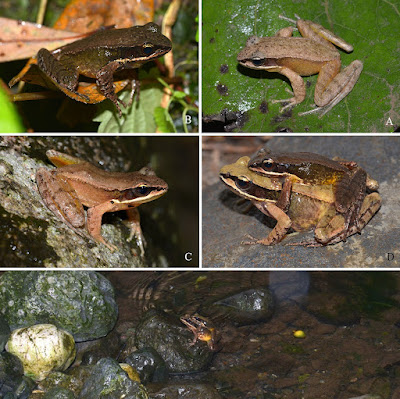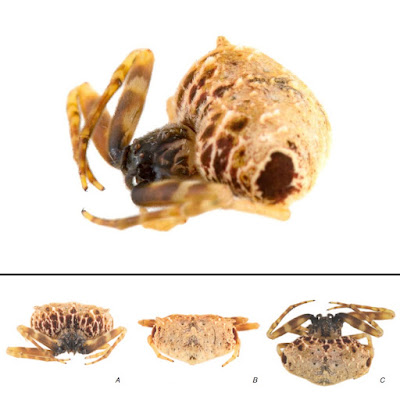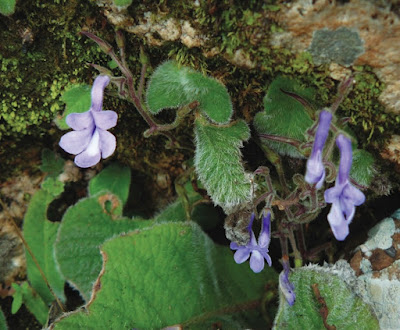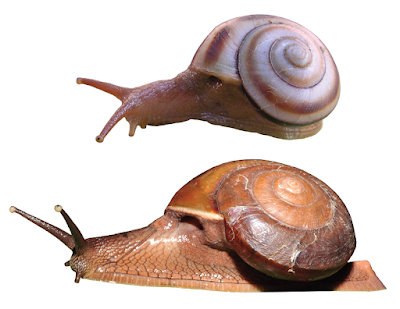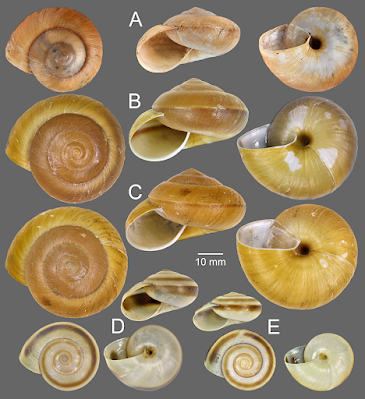[Most Recent Entries] [Calendar View]
Thursday, September 30th, 2021
| Time | Event | ||||
| 8:50a | [Herpetology • 2021] Amolops chaochin • Taxonomic Revision of Amolops chunganensis (Pope, 1929) (Anura: Ranidae) and Description of A New Species from southwestern China, with Discussion on Amolops monticola group and Assignment of Species Groups of the
Abstract Amolops chunganensis is a species complex and reported widely from eastern, southern, and southwestern China. Based on molecular data of 19 populations of A. chunganensis sensu lato from China, including the population from Mt. Wuyi (type locality), we recognize A. chunganensis sensu stricto and provide an expanded description based on the topotypic specimens. Combining morphological and molecular data, we describe a new species, Amolops chaochin sp. nov., from southwestern China, which was previously identified as A. chunganensis. The new species is distinguished from all other species in the A. monticola group by: (1) moderate body size, SVL 35.3−39.2 mm in males (n=7), and 50.5−54.4 mm in females (n=7); (2) distinct tympanum, larger than half of eye diameter; (3) small tooth-like projection on anteromedial edge of mandible; (4) circummarginal groove on all fingers; (5) white tubercles on dorsal side of posterior body in both sexes; (6) distinct tubercles on dorsal thigh and white spinose tubercles on dorsal tibia in both sexes; (7) white tubercles on posterior region of tympanum in males; (8) toe webbing reaching disk by dermal fringe on inner side of toe II; (9) vomerine teeth present; (10) transverse bands on dorsal limbs; (11) external vocal sacs present in males. We further reviewed the assignment of Amolops groups, with an overall revision of membership and diagnosis of all species groups. Keywords: Amolops chaochin sp. nov., Complex, Distribution, Amolops gerbillus, Amolops chayuensis group, Amolops spinapectoralis group Amolops chaochin sp. nov. Jiang, Ren, Lyu, and Li Diagnosis: According to the morphological characters of the A. monticola group stated by Stuart et al. (2010), Amolops chaochin sp. nov. is placed in the A. monticola group based on the following diagnosis: (1) skin relatively smooth; (2) dorsolateral fold distinct; (3) lateral side of head black, upper lip stripe yellowish white extending to shoulder. Amolops chaochin sp. nov. is distinguished from all other congeners in the A. monticola group by the following combination of characters: (1) moderate body size, SVL 35.3−39.2 mm in males (n=7) and 50.5−54.4 mm in females (n=7); (2) tympanum distinct, larger than half of eye diameter; (3) small tooth-like projection on anteromedial edge of mandible; (4) circummarginal groove on all fingers; (5) white tubercles on dorsal side of posterior body in both sexes; (6) distinct tubercles on dorsal thigh and white spinose tubercles on dorsal tibia in both sexes; (7) white tubercles on posterior region of tympanum in males; (8) toe webbing reaching disk by dermal fringe on inner side of toe II; (9) vomerine teeth present; (10) transverse bands on dorsal limbs; (11) external vocal sacs present in males. Etymology: Specific epithet “chaochin” is named after Prof. Ch’eng-Chao Liu (1900–1976) and his wife Prof. Shu-Chin Hu (1914–1992), combining the last words of their given names “Chao” and “Chin”. Prof. Liu and Prof. Hu both greatly contributed to Chinese herpetology and established the Herpetological Museum at the Chengdu Institute of Biology, Chinese Academy of Sciences. During their fieldwork in Mt. Emei, Prof. Liu and Prof. Hu found the first pair of specimens of this new species. Furthermore, based on field observations from 1938 to 1940, Prof. Liu published the detailed life history of this new species under the name “Staurois chunganensis” (Liu 1941), and the specimens collected by Prof. Liu are still preserved in CIB (Figure 8A). We suggest the English common name as “Chaochin’s Torrent Frog” and the Chinese common name as “钊琴湍蛙 (in Chinese Pinyin: Zhāo Qín Tuān Wā)”.
Ke Jiang, Jin-Long Ren, Zhi-Tong Lyu, Dan Wang, Zeng Wang, Ke Lv, Jia-Wei Wu and Jia-Tang Li. 2021. Taxonomic Revision of Amolops chunganensis (Pope, 1929) (Amphibia: Anura) and Description of A New Species from southwestern China, with Discussion on Amolops monticola group and Assignment of Species Groups of the Genus Amolops. Zoological Research. 42(5); 574-591. DOI: 10.24272/j.issn.2095-8137.2021.107 | ||||
| 8:52a | [Arachnida • 2021] Taczanowskia onowoka • Phylogenetic Placement of the Spider Genus Taczanowskia (Araneae: Araneidae) and Description of A New Species from Ecuador
Abstract The genus Taczanowskia Keyserling, 1879 is one of the rarest groups of spiders in the orb-weaving family Araneidae, with only five species described and 17 specimens cited in publications. Our study provides new insights into the evolutionary relationships and diversity of Taczanowskia. Using morphological data, we tested the evolutionary relationships of the genus within the family Araneidae and propose the first phylogenetic hypothesis depicting the relationships among species of Taczanowskia. Our results place Taczanowskia as sister to Mastophora Holmberg, 1876, and confirm the monophyly of Taczanowskia. We describe the first species of Taczanowskia from Ecuador, collected at a Waorani community on the River Curaray basin, Amazonian lowlands of Ecuador. The new species can be easily diagnosed from all other species of Taczanowskia by having two tubercles in the opisthosoma; a distinct patchy dark–light colouration pattern with dark spots concentrated towards the anterior margin and on the lateral tips; small bundles of white setae forming a reticulum across the dorsal part of the opisthosoma, and the first two femora thick but lacking teeth on the margin. Juan Pablo Jordán, Mariela Domínguez-Trujillo and Diego F. Cisneros-Heredia. 2021. Phylogenetic Placement of the Spider Genus Taczanowskia (Araneae: Araneidae) and Description of A New Species from Ecuador. Invertebrate Systematics. 35(7); 742-753. DOI: 10.1071/IS20084 | ||||
| 1:32p | [Botany • 2021] Streptocarpus malachiticola, S. bampsii, S. malaissei, et al. • Five New Species of Streptocarpus (Gesneriaceae) from Katanga, D.R. Congo
Abstract Background and aims – Five new species of Streptocarpus (Gesneriaceae) are described from D.R. Congo in connection with preparing the family treatment for the Flore d’Afrique centrale. Methods – Standard herbarium practices were applied. Key results – Streptocarpus malachiticola sp. nov. is related to S. compressus and S. goetzei while S. bampsii sp. nov., S. malaissei sp. nov., S. salesianorum sp. nov., and S. schaijesii sp. nov. are related to S. michelmorei and S. solenanthus. The differences with these species are discussed and distribution maps for the new taxa are presented. An identification key for all known acaulescent species from D.R. Congo, Rwanda, and Burundi is provided. The conservation status of new species is preliminarily assessed. All taxa are range-restricted in Upper Katanga and the assessments are as follows: S. malachiticola: EN B1+2ab(iii), S. bampsii: CR B2ab(iii), S. malaissei: EN B1+2ab(iii), S. salesianorum: CR B2ab(iii), and S. schaijesii: EN B2ab(iii). Streptocarpus malachiticola is found on metalliferous rocks while the remaining species are either epiphytes in gallery forests (S. bampsii) or occur on humid rocks in gallery forests. Keywords: central Africa, endemism, new species, Streptocarpus malachiticola, S. bampsii, S. malaissei, S. salesianorum, S. schaijesii, taxonomy Streptocarpus malachiticola Eb.Fisch. & I.Darbysh., sp. nov. Diagnosis – Streptocarpus malachiticola differs from S. goetzei in the glandular-pubescent pedicel with shorter eglandular hairs intermixed, the glandular-pubescent calyx, the smaller corolla with glandular hairs outside, the glandular-pubescent ovary, the bilobed stigma and the distinctly shorter capsule. The upper lip of the corolla bears strongly divaricate lobes, thus also differing from S. goetzei. It differs from S. compressus in the strictly unifoliate habit, the glandular-pubescent calyx, the shorter lower lip of the corolla, the blue-violet corolla with pale-whitish palate, the shape of the upper lobes and the more strongly constricted mouth, the eglandular style and the shorter capsules. Habitat – Shaded vertical siliceous rock faces, often on metalliferous rocks, e.g. malachite, or rarely on non-mineralized rocks, 1200–1500 m elevation. Malachite is a copper carbonate hydroxide mineral [Cu2CO3(OH)2]. It often results from the weathering of copper ores. Etymology – Named after the metalliferous rocks which are the preferred habitat. Streptocarpus bampsii Eb.Fisch. & I.Darbysh., sp. nov. Diagnosis – The species differs from Streptocarpus solenanthus in the straight and usually shorter corolla tube and the shorter lower lip of the corolla, the darker colouring of the corolla lobes and the longer calyx lobes. The species differs from Streptocarpus michelmorei in the smaller pale lilac corolla lacking a deep violet patch on the palate and behind, the corolla tube being almost straight and not deepened on the lower side at the middle, and the upper and the lower lip being almost equal while in S. michelmoreithe lower lip is distinctly larger. It also differs from S. michelmorei in the distinctly shorter capsule. Habitat – Epiphyte in gallery forest at foot of waterfalls, 1250 m elevation. Etymology – Named after Paul Bamps, who made major contributions to the knowledge of the flora of Central Africa, and who collected the type. Streptocarpus malaissei Eb.Fisch. & I.Darbysh., sp. nov. Diagnosis – The species differs from Streptocarpus michelmorei in the smaller pale lilac corolla lacking a deep violet patch on the palate and behind, the corolla tube being almost straight and not deepened on the lower side at the middle, and the upper and the lower lips being almost equal while in S. michelmorei the lower lip is distinctly larger. It also differs from S. michelmorei in the distinctly shorter capsule. The species differs from Streptocarpus solenanthusin the straight and usually shorter corolla tube and the shorter lower lip of the corolla. It differs from the morphologically similar Streptocarpusbampsii in the deep violet corolla with pale violet tube, shorter ovary and style and the shorter capsule. Habitat – Epiphyte or lithophyte on humid rocks in gallery forest or ravine near waterfall, 1450 m elevation. Etymology – Named after François Malaisse, who made major contributions to the knowledge of the flora of Katanga, and who collected the type. Streptocarpus salesianorum Eb.Fisch. & I.Darbysh., sp. nov. Diagnosis – Streptocarpus salesianorum differs from all other related species even at first glance by the orbicular leaf with a length/width ratio of ca 1. The flowers are similar to that of S. schaijesii but differ in the much shorter tube and the distinctly shorter upper and lower lips. There is an overall similarity to S. solenanthus but the latter species has a corolla with shorter upper lip and a distinctly longer lower lip and a much more ovate to oblong leaf (7–15 × 4–12 vs 25–27 × 24.5–26.5 cm in S. salesianorum). Habitat – Humid rocks along stream, ± 1450 m elevation. Etymology – Named after the Salesian missionaries from Institut Saint François de Sales at Lubumbashi (= Elisabethville) who collected the type specimen. Streptocarpus schaijesii Eb.Fisch. & I.Darbysh., sp. nov. Diagnosis – The species differs from Streptocarpus michelmorei in the pale lilac corolla lacking a deep violet patch on the palate and behind, in the corolla tube being only slightly curved and scarcely deepened on the lower side at the middle, and in the distinctly shorter capsule. The species differs from Streptocarpus solenanthus in usually having a shorter corolla tube and in the longer lower lip of the corolla. It differs from Streptocarpusbampsii in the slightly curved and longer corolla tube, the longer corolla lower lip and the longer staminodes. Habitat – Humid, calcareous rocks in gallery forest or ravine near waterfall, 1200–1650 m elevation. Etymology – Named after Michel Schaijes, who made major contributions to the knowledge of the flora of Katanga, and who collected the type. Eberhard Fischer and Iain Darbyshire. 2021. Five New Species of Streptocarpus (Gesneriaceae) from Katanga, D.R. Congo. Plant Ecology and Evolution. 154(2); 264-280. DOI: 10.5091/plecevo.2021.1824 | ||||
| 1:34p | [Mollusca • 2020] Hemiplecta ligorica & H. thailandica • Reassessment and Systematic Position of the Sinistral Snails of Genus Hemiplecta from Thailand (Eupulmonata: Ariophantidae), with Description of Two New Species
Abstract Indochina land snails of the family Ariophantidae are in need of thorough systematic revision. Here we comprehensively revise the systematics of the large-shelled, sinistral (counterclockwise) coiling snails from Thailand and Peninsular Malaysia. Molecular phylogeny based on mitochondrial (coi and 16S) and nuclear (28S) gene sequences demonstrates that these sinistral snails are not members of Dyakiidae as previously thought, but instead are more closely related to the genus Hemiplecta in the family Ariophantidae. Comparative morphology also reveals similarity of reproductive organ features (globular gametolytic organ, well-developed dart apparatus, and lack of amatorial organ complex). Based on this evidence, we propose to transfer these sinistral snails to the genus Hemiplecta. Molecular phylogenetic analyses further strongly support the monophyly of this sinistral lineage with respect to other members of Hemiplecta. This monophyletic clade consists of five members including three species that were previously classified as “Dyakia”, H. lahatensis, H. retrorsa and H. salangana, and two new species described herein, Hemiplecta ligorica n. sp. and H. thailandica n. sp. This study also suggests that the anatomy of the gametolytic organ in the genus Hemiplecta corresponds well with the phylogenetic relationships and appears to be a taxonomically informative character, while the penial verge has little utility for generic recognition. Keywords: Pulmonata; Dyakiidae; sinistral; endemic species; Indochina Family Ariophantidae Godwin-Austen, 1888 Genus Hemiplecta Albers, 1850 1. Hemiplecta retrorsa (Gould, 1843) 2. Hemiplecta salangana (Martens, 1883) 3. Hemiplecta lahatensis (Morgan, 1885) 4. Hemiplecta thailandica Sutcharit and Panha, n. sp. Etymology. The species name “thailandica” refers to the type locality of this new species in Chanthaburi Province, Thailand. Diagnosis. Large and low conic shell with brown to brownish yellow shell color, rounded last whorl with narrow dark brown spiral band on periphery. Penial sculpture with small penial papillae arranged over nearly entire penis length. 5. Hemiplecta ligorica Sutcharit and Panha, n. sp. Etymology. For the historical name of Nakhon Si Thammarat Province, where the type locality is situated. Diagnosis. Small, sinistral helicoild shell with whitish color, rounded last whorl with dark brown to brownish spiral band on periphery and upper shell surface. Penial sculpture with small papillae arranged over about half of penis length. Conclusion: Based on phylogenetic results and morphological information in the present study, we have transferred the sinistral species previously and incorrectly assigned to Dyakia (family Dyakiidae) to the genus Hemiplecta (family Ariophantidae). Two previously unrecognised species are described based on consistent differentiation in molecular, shell, and genitalia characters. Our data also provide further support for three other sinistral Hemiplecta species, which are also re-described herein. The results also suggest the synonymization of the formerly recognized as (sub)genus Koratia under the Hemiplecta. Finally, the results indicate the evolutionary instability of shell traits that are often used for land snail classification, while genital characters are highlighted as reliable taxonomic markers for delimiting species and at least some higher taxa. The integration of multiple independent characters including molecular evidence is crucial for delimiting higher systematic levels. Chirasak Sutcharit, Ekgachai Jeratthitikul, Piyoros Tongkerd and Somsak Panha. 2021. Reassessment and Systematic Position of the Sinistral Snails of Genus Hemiplecta from Thailand (Eupulmonata: Ariophantidae), with Description of Two New Species. Contributions to Zoology. 90(2); 183–215. |
| << Previous Day |
2021/09/30 [Calendar] |
Next Day >> |
